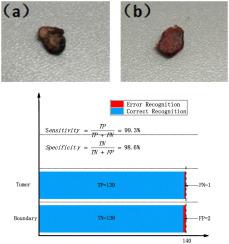Spectrochimica Acta Part B: Atomic Spectroscopy ( IF 3.2 ) Pub Date : 2021-04-11 , DOI: 10.1016/j.sab.2021.106200 Xiaomei Lin , Haoran Sun , Xun Gao , YuTing Xu , ZhenXing Wang , Yue Wang

|
The boundary between lung tumor and boundary tissue is blurry. If tumor resection is not complete, recurrence may affect patient survival. Laser-induced breakdown spectroscopy (LIBS) is used to distinguish lung tumor and boundary tissues. Support Vector Machine(SVM)and Boosting Tree classification models combine Principle component analysis (PCA) or Random forest (RF) to optimize input variables to enhance accuracy, sensitivity, specificity, ROC curves, and AUC through 10-fold cross-validation. The RF-Boosting Tree model shows the highest accuracy (98.9%). RF feature selection better retains data information, removes redundant information and interference, and reduces training time. LIBS and an RF-Boosting Tree model is a rapid and robust method for identification of lung tumor boundaries.
中文翻译:

基于激光诱导击穿光谱和机器学习的肺肿瘤和边界组织鉴别
肺肿瘤和边界组织之间的边界模糊。如果肿瘤切除不完全,复发可能会影响患者的生存。激光诱导击穿光谱法(LIBS)用于区分肺部肿瘤和边界组织。支持向量机(SVM)和Boosting Tree分类模型结合了主成分分析(PCA)或随机森林(RF)来优化输入变量,以通过10倍交叉验证来增强准确性,灵敏度,特异性,ROC曲线和AUC。RF-Boosting树模型显示了最高的准确性(98.9%)。射频功能选择可以更好地保留数据信息,消除冗余信息和干扰,并减少训练时间。LIBS和RF-Boosting树模型是用于识别肺肿瘤边界的一种快速而强大的方法。











































 京公网安备 11010802027423号
京公网安备 11010802027423号